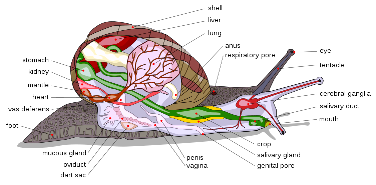Nutrition
 This snail favors neutral and
calcareous, calcium containing, sites for its search for food. (Nekola,
2010) The Vertigo meramecensis is not a parasite and is
not used as a host for other organisms. The bluff vertigo was
found on mosses and lichens so they follow the diet of a
herbivore. This diet usually consists of fungi, algae, leaves,
bark, fruits and vegetables. Sources of calcium are also
desired in order to keep their shell strong. This is another
reason this species is found in calcareous rich environments.
(Nekola, 2003) The Vertigo genus ingests using
its radula as well as its small teeth which scrapes up food
which is transferred to the digestive tract. Since the bluff
Vertigo snail is a member of the order Stylommatophora, it has
the same general internal structures to others in that order.
The picture at the top shows the one way digestive system these
snails possess. The food is ingested through the mouth then held
in the crop where salivary glands contain digestive enzymes. The
food proceeds to the stomach then is removed by the anus.
Members of the order Stylommatophora have an open circulatory
system. This circulatory system consists of a heart, vessels,
and a sinus. The components of the circulatory system work
together to filter the hemolymph, and remove wastes through the
nephridophore. (
This snail favors neutral and
calcareous, calcium containing, sites for its search for food. (Nekola,
2010) The Vertigo meramecensis is not a parasite and is
not used as a host for other organisms. The bluff vertigo was
found on mosses and lichens so they follow the diet of a
herbivore. This diet usually consists of fungi, algae, leaves,
bark, fruits and vegetables. Sources of calcium are also
desired in order to keep their shell strong. This is another
reason this species is found in calcareous rich environments.
(Nekola, 2003) The Vertigo genus ingests using
its radula as well as its small teeth which scrapes up food
which is transferred to the digestive tract. Since the bluff
Vertigo snail is a member of the order Stylommatophora, it has
the same general internal structures to others in that order.
The picture at the top shows the one way digestive system these
snails possess. The food is ingested through the mouth then held
in the crop where salivary glands contain digestive enzymes. The
food proceeds to the stomach then is removed by the anus.
Members of the order Stylommatophora have an open circulatory
system. This circulatory system consists of a heart, vessels,
and a sinus. The components of the circulatory system work
together to filter the hemolymph, and remove wastes through the
nephridophore. (